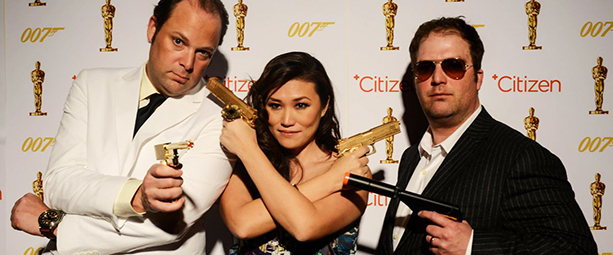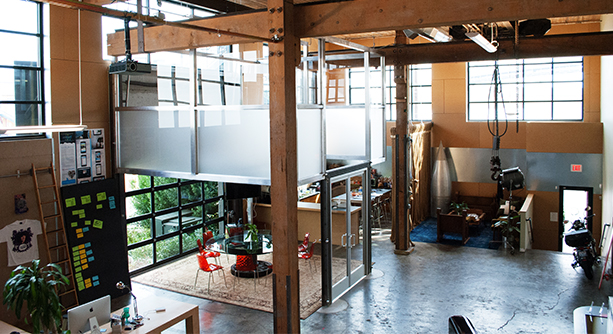The collective hearts at Citizen, Inc. beat for mobile. Known for creating market-shifting mobile experiences for Intel, Adidas, Samsung and Disney/ABC, the crack squad at Citizen, Inc. recently decided to take on the weighty challenge of exploring how technology is impacting our individual and shared experiences and what that means for ourselves and our souls.
This week, during Design Week Portland, you’ll have the chance to get close and personal with these mobile innovators’ work at AIGA Portland’s exhibit, Blurred Lines: A Curated Exploration of the Future of Interaction. held October 9-11, 2013 at Refuge PDX.
We asked Citizen, Inc. a few questions about their Blurred Lines installation. This is what they had to say:
What are you creating for Blurred Lines and who is the team working on it?
If you don’t have a digital soul, death is permanent. Earth’s religious leaders and philosophers have offered us many possibilities for understanding our souls, but no one knew what was true. We now know that they were only starting to understand the soul. Because we have matured, God has given us the technology to capture the full complexity of each unique human being, the gift of the digital soul. Join us at Urvan, Inc. and invest in the eternal life of your soul.
It’s a fun, tongue-in-cheek sales pitch of something very complex and controversial.
This project was the brainchild of CXO Scé Pike, who came up with the concept. Development was done by Scott Hooper and Simon Vansintjan, with amazing evolution of the idea and project from Nicki Vance, and visual support from Becca Charlier-Matthews.

Citizen at the Oscars
Scé, how did you come up with this?
I was listening to a podcast from Radiolab about quantum physics when a physicist mentioned that if we could map every cell, every atom, every neuron in our bodies then print that exact state, we can have our selves back again, exactly as we were at that moment. Which made me wonder…what about the soul? Where is the soul in our brain cells, where in the the neural pathways as they fire? Where is the soul in that equation?
For many physicists and neuroscientists, the brain is what makes us who we are, but I was raised to believe there is more than what can be seen and measured. We are not exclusively the sum of the matter that makes up our physiology, we are a collection of our past—of memories, of sensory experiences. We are also what others perceive us to be, as much as we may dislike this thought, the way others think of us influences who we are as individuals. So just our own biological material does not complete our sense of self. We are social animals that need a mirror to be able to reflect ourselves upon.
This got me thinking, if the physicist predicts we can recreate our bodies, that gets us halfway there, but for us to fully recreate ourselves, we will need every little bit of ourselves, our memories, and the memories and perception from others. This is being collected every day through our social networks, our emails, our calendars, our phones, etc. With the Quantified Self movement, along with the likes of Amazon and Google, collecting data about us we may be able to create a Digital Soul that completes the picture and fills the hollow shell of our bodies with the spark that animates us and makes us who we are.
This Digital Soul will replace the traditional belief about the soul.
That’s amazing. I love the idea of redefining soul. What do you hope will be people’s reaction after experiencing Urvan, Inc.?
I hope someone gets inspired to create/recreate the soul, create a new religion or start a new company to create life everlasting—not in the digital world but in this world populated by digital content.
What has been your favorite part this project and process so far?
Thinking about what the possibilities will be for transferring our physical and emotional selves into machines, and what could happen with that data once it has left the human body.
So, will humans someday have the option to spend their entire life in an alternate reality, like an Avatar, only happier?
Wait, what is reality again?
Exactly. If your installation embodied a song, what would it be?
“Resurrection Fern” by Iron and Wine

Where the magic happens.
Which coffee fuels your design team?
In a perfect world, we would have endless cups of Stumptown Cold Brew. We also enjoy the fine coffees from Ristretto Roasters.
I would buy Cold Brews just for the packaging. What excites you about the creative scene in Portland?
The fact that so many people take it upon themselves to make things happen. The Portland creative community has little fear of approaching new ideas, and finding a way to get it done.
And what are the biggest challenges that Portland’s creative scene faces?
There seems to be a stigma around taking businesses to the next level and professionalizing something that has DIY roots. We need to support our Portland success stories.
Finally, what is good design?
Good design is anything that has inserted itself into our daily lives since the dawn of civilization and has evolved humanity and our culture. This can range from the first invention of paper being designed rectangular vs. square or circular, all the way to innovations in business models that allow us to have things such as cash and credit vs. bartering goods. Good design is made by Great Designers. Check out our Stream on what makes a Great Designer.
Citizen are going to be all over Design Week Portland, so be sure to visit their studio, watch their reel and check out some technomagical birdhouses.
Of course, you too can experience Citizen’s Urvan, Inc. October 9–11 at Blurred Lines: A Curated Exploration of the Future of Interaction—where leading design studios in Portland share their experiences of what can (and may) happen when light, sound, images, motion, culture and history combine. Explore a space like you’ve never imagined, grab a drink at the bar and groove on music spun by different DJ’s each night.
Buy your tickets now at: http://blurredlines.eventbrite.com